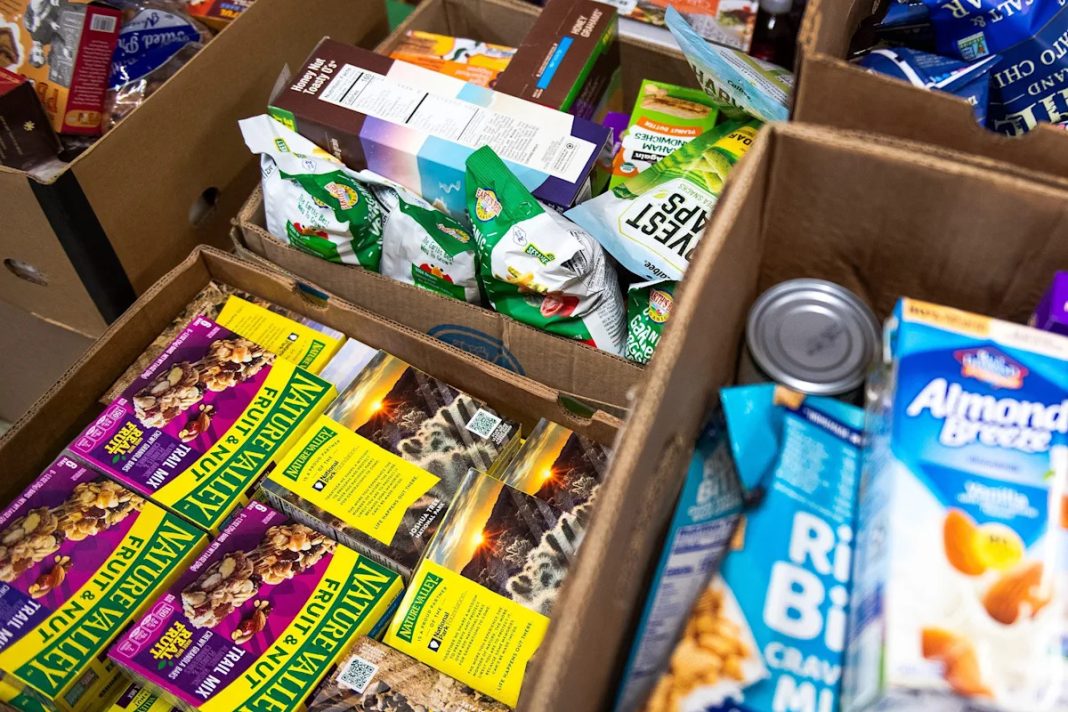At a Des Moines, Iowa, food bank, clients who used to come occasionally are now regulars.
The number of visitors has steadily risen in the last two years, as COVID-19 pandemic relief programs ended, said Andrea Cook, executive director of the Johnston Partnership, which runs the food bank.
And now, Supplemental Nutrition Assistance Program, or SNAP benefits aren’t expected to arrive in full in November because of the government shutdown.
The shortfall will leaving 42 million people scrambling to find food, and food banks like Cook’s nationwide bracing for a wave of new clients desperate for a meal.
Two federal judges on Oct. 31 ordered the U.S. Department of Agriculture to distribute its reserves, which will provide about two-thirds of the usual funds and will delay distribution by at least a few days. The rulings are likely to be appealed.
“We’re in this kind of world right now, trying to plan for what happens if everybody who has come needing food from us over the course of the year comes in the same month,” Cook said.
Johnston Partnership normally sees 2,500 to 3,000 individuals a month. Many are working, trying to balance multiple jobs and are between the ages of 18 and 59 years old, she said.
Cook is trying to stay optimistic, but knows food banks aren’t able to replace SNAP.
“I try to be a glass half-full kind of person, but I am wondering if we’re going to find out what the limitations are to the charitable food and security network in the community,” she said. “I feel like we’re going to get to January, and we may be surprised to find that there could be some organizations that are not able to keep up.
An assortment of food sits at the Food Bank for Larimer County in Fort Collins, Colo. on Oct. 28, 2025. Food Bank for Larimer County is feeling the pinch as the government shutdown stretches on, endangering SNAP benefits for 600,000 Coloradans.
The delay in benefits, announced less than a week ago by USDA, is the first time federal food security has not arrived in the program’s more than 60-year history.
Food banks and pantries told USA TODAY they are expecting a massive influx of need in the coming days, which could stretch the already strained food safety net beyond what it can handle.
How to help the hungry
Food banks and programs are already coordinating, sharing information and food, said Laura Glaza, executive director of the Glenn House Food Pantry, in the Chicago suburbs. And they know that people want to help.
“The bottom line right now is donating money is probably the most impactful thing that people could do to help food banks and food pantries right now,” Glaza said. “Volunteer your time and spread the word, let people know about what we’re facing and encourage other people to make a difference, too.”
She knows her staff and volunteers are going to feel the full force of SNAP recipients’ panic early next week.
“We’re worried about Monday,” she said. “Monday is going to be a very stressful day for our staff and for the neighbors who we’re trying to get food to.”
Linda Nageotte, president and COO of Feeding America, which provide millions of meals worth of food support to organizations across the country, said food banks and pantries need all available support.
“We need everyone who is in a position to give and to support to do so,” Nageotte said. “Please donate to your local food bank. You can sign up to volunteer. We need lots of hands and hearts engaged in our work to help us get food out to families who need it.”
But mostly, they need the government to reopen, federal workers to be getting their paychecks and SNAP to be fully funded, she said. She urged people to call their members of Congress.
Government shutdown having an impact
On Oct. 27, the U.S. Department of Agriculture said it can’t use the roughly $6 billion in its contingency fund account to pay for SNAP, although the agency has used it in at least two previous shutdowns, including the 2018 to 2019 shutdown during President Donald Trump‘s first term, which lasted 35 days.
A U.S. Senate vote Oct. 28 failed to reopen the government ‒ for the 13th time ‒ as Americans endure what is already the second-longest shutdown in history. Both the House and Senate are gone for the weekend as Democrats and Republicans blame one another.
USDA and House Speaker Mike Johnson, a Louisiana Republican, have said they cannot legally provide the benefits. Democrats say the Trump administration can use the contingency fund and tap into other money to make the November payment.
On Oct. 31, two federal judges ruled that USDA must fund benefits in November. One judge gave the federal government the weekend to decide how they will do so, while the other judge ordered the agency to use contingency funds. The decisions could be appealed to the 1st Circuit before going into effect.
The USDA has historically used contingency funds to ensure benefits were not interrupted during shutdowns, but now claims it cannot legally issue the money.
“Bottom line, the well has run dry. At this time, there will be no benefits issued November 1,” the agency stated in a message on its website.
Little notice or time to prepare
The lack of notice has left millions of recipients and food banks scrambling.
Glaza said her food pantry in DuPage County, a wealthy suburb of Chicago is going to be open more hours, and let more people in at a time. They will go from 300 opportunities for people to shop the last week of October to 436 the first week of November.
The pantry already serves 10% of the county’s residents, a number she expects to jump when 76,000 people lose SNAP benefits.
Danielle Perry, vice president of the Greater Chicago Food Depository, said they are already serving 175,000 households a month, an amount near what they served at the height of the COVID-19 pandemic.
“So we are now walking into a new crisis at the height of need,” she said.
To prepare for the expected spike “we have taken everything we had in our inventory and given it out to the pantries so that they are prepared for (Nov. 1),” she said. “Honestly, this week alone we’ve seen an uptick, sometimes twice as many, three times as many people coming to the pantries.”
As of the last week of October, they were already purchasing food to replenish warehouses for the second week of November and are doing additional distributions of boxes of shelf stable foods in areas with high SNAP participation.

The U.S. Department of Agriculture website announced how food benefits would be impacted due to the government shutdown.
In fiscal year 2025, the average monthly benefit per person in the SNAP program was $190.59, according to the USDA. For households, the average monthly benefit was $356.41 in total.
Around 12% of the more than 342 million people in the United States rely on the federal program, which provides low-income families with monthly benefits to afford healthy food.
According to the USDA’s fiscal year 2019 annual report of demographics of SNAP users, 36% of recipients were White, and 26% were Black. It also shows that 43% of participants were children, 32% were nondisabled, non-elderly adults, 16% of participants were age 60 or older, and 10% were non-elderly adults with disabilities.
Local government steps up
Some states, counties and local governments across the country are giving revenue directly to food banks, but stress that it will not be enough.
Coconino County, Arizona Treasurer Sarah Benatar said they are holding a county-wide food drive.
New Mexico Gov. Michelle Lujan Grisham, a Democrat, said in a statement that her administration was expediting $8 million for food banks, which is “only a fraction of the $80 to $90 million in monthly SNAP benefits New Mexicans rely on.”
West Virginia Gov. Patrick Morrisey, a Republican, has started a statewide donation drive to support food banks. The state had identified up to $13 million in funding to match private and charitable donations, potentially delivering $26 million in total food assistance statewide, according to the governor’s website. West Virginians receive about $47 million in SNAP benefits each month.
Connecticut Gov. Ned Lamont, a Democrat, announced that the state would provide $3 million in emergency funds to Connecticut Foodshare, a nonprofit that supports food banks.
Virginia Gov. Glenn Youngkin, a Republican, announced that an additional $1 million in state funds would be sent to Virginia food banks in November.

Volunteers pack boxes of food, Monday, Oct. 27, 2025, at the Greater Lansing Food Bank in Michigan.
Ohio Gov. Mike DeWine, a Republican, said the state will spend $25 million on food banks and aid for low-income families as more than 1 million Ohioans prepare to lose money from the federal government.
Preparing for the onslaught
Staff at the Alameda County Food Bank in Oakland California are gearing up to help the more than 175,000 county residents who may be impacted, said Mike Altfest, the food bank’s community engagement director.
Altfest said the food bank already provides 4.2 million meals a month in the county and he can see that figure easily doubling with local federal employees not getting paid ‒ in addition to those losing SNAP benefits ‒ all due to the shutdown.
“Ultimately, when there are fewer resources, the burden shifts to food banks. That’s what we are looking at and we’re planning to mitigate,” Altfest said. “We’ll definitely be adding more meals and services for the foreseeable future.”
“We have the resources right now to ramp up our operations,” Altfest added, which includes more volunteers and pop-up distribution sites. “But there’s still a lot that remains to be seen.”
Claire Neal, the CEO of MANNA Foodbank in Asheville, North Carolina, said the demand for food in the region is even greater than during the COVID-19 pandemic or after Hurricane Helene devastated the state a year ago.

Frank Coverdale (center) shows Kim Turner (right) how to electronically process visitors during the Food Bank of Delaware’s mobile pantry event on October 23, 2025.
“We were already in a situation where food was flying off the shelves,” Neal told USA TODAY. “It’s a one-two punch. It’s going to mean that children are going to go without food, families are not going to be able to put food on the table.”
MANNA collects food and wheels it out to 220 pantries and 100 schools in western North Carolina, Neal said. The pantries aim to provide enough food to tide people over for a couple of weeks. But for every one meal the pantries provide, SNAP benefits provide nine, she said.
“Nobody could make up a gap that big,” Neal said.
The community is already stressed economically while recovering from Helene. The threatened loss of SNAP benefits has people anxious, particularly senior citizens on fixed incomes, Neal said.
“There is a very high level of fear right now. So many people rely on SNAP to get them through,” Neal said. “Our neighbors are scared about what this is going to mean.”
Contributed: USA TODAY reporters Bart Jansen and Terry Collins, and Des Moines Register reporter F. Amanda Tugade.
This article originally appeared on USA TODAY: Food banks expect wave of new users from SNAP shutdown

